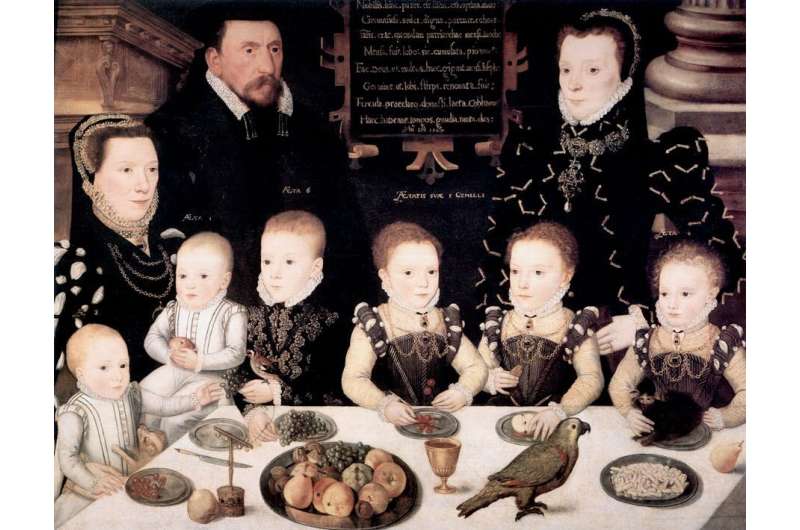This article has been reviewed according to Science X's editorial process and policies. Editors have highlighted the following attributes while ensuring the content's credibility:
fact-checked
trusted source
written by researcher(s)
proofread
How the Tudors dealt with food waste

More than 10 million tons of food is wasted in the UK each year. Leftovers perish in their plastic Tupperware tombs, supermarket bins heave with damaged but perfectly edible produce, and fields are littered with spoiled harvests. Preventing good food from ending up in the bin is an important part of the global fight against climate change.
But what about the past? How did our ancestors deal with food waste? Surprisingly, given the pertinence of the issue in modern discourse, very little has been written about the history of food waste. My new book, "Leftovers: A History of Food Waste and Preservation," addresses the topic across the last half a millennium, from the Tudor kitchen right up until the present day.
Tudor society was intrinsically religious. Henry VIII's well-known divorce issues ignited the English Reformation, the tumultuous transformation from Catholicism to Protestantism, heightening religious fervor and shaping attitudes towards food across the country.
In Tudor eyes, food was the ultimate gift from God that literally sustained life on earth. And in the form of the bread and wine, it was food that Christ had chosen to represent his body and blood at the Last Supper. No wonder that wasting food was seen as sinful and immoral. "The least crum, which can be saved, be not lost," commanded the Puritan writer Ezekias Woodward, "no, not a crum."
Familiar to many of us today, clergymen taught their parishioners about the feeding of the 5,000. In the Biblical tale, when Jesus went to mourn the passing of John the Baptist, the large crowd that followed him were miraculously fed on just five loaves and two fish. According to the Gospel of John, at the end of the meal, Christ told his disciples to "gather the pieces that are left over," so "nothing be wasted," and they collected 12 full baskets of leftovers.
In another Biblical parable, the rich man Dives went to hell when he denied the scraps of his feast to the poor man Lazarus, who instead ascended to heaven. Like Lazarus, the Tudor poor waited at the gates of grand estates to receive the remains of lavish feasts. An almoner (a church official who was responsible for distributing money or food to the poor) collected leftovers but also the first slices of meat to be given in charity.
Leftovers
Even those from humbler backgrounds could donate surplus food. Instead of throwing it to the pigs, the whey left over from cheese making, for example, could become a nourishing summer drink for the laborers who toiled in the hot fields.
Charitable housewives who expressed their piety by distributing such leftovers to their poor neighbors would "find profit therefore in a divine place," according to Gervase Markham in his popular 1615 cookery book.
As well as being distributed to the poor, the leftovers from large Tudor households went to employees rather than going to waste. In Queen Elizabeth I's royal household, workers who cooked meats in the "boiling house" received the "dripping of the roste" and even "the grease… in the kittles (kettles) and pannes" as a benefit for their labor. A waste product to those with plenty, these meat juices could be reimagined to add flavor and nutrition to sauces and gravies.
Still, those at the top of the social scale had access to far more than they could possibly eat. Elizabeth's table overflowed with elaborate pies, roasted meats, sugar sculptures, imported wines and exotic fruits.
Waste and hunger
Meanwhile, widespread hunger led to rioting across the country in the 1590s after years of devastating harvests. As wealthy landlords closed off their land to common pasture, flour prices tripled over the span of just a few years.
In the Bible, Ruth gleaned from the field of a wealthy man named Boaz, in accordance with the Old Testament law: "when ye reap the harvest of your land, thou shalt not wholly reap the corners of thy field…thou shalt leave them for the poor and stranger." With this example, the poorest in Tudor England collected the scraps from the harvest to feed themselves and their families.
Squaring these disparate images of plenty and want is not too hard when we consider that in the UK 9.7 million adults experience food insecurity according to data from September 2022. Meanwhile the richest 5% take home 37% of the nation's total disposable income. On a global scale, a third of the food we produce goes to waste while 842 million people are afflicted with chronic hunger.
Food waste today is a pressing environmental issue. But this foray into Tudor food waste reminds us that it is also a deeply moral issue that reflects the growing inequalities between the rich and the poor. In telling the so far untold history of food waste, my research reflects on our changing moral values, and our relationship with food, people and planet.
Provided by The Conversation
This article is republished from The Conversation under a Creative Commons license. Read the original article.![]()



















